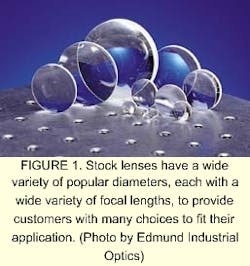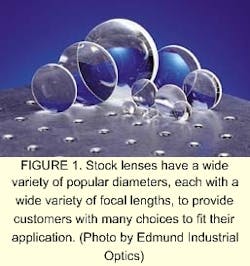Off-the-shelf optics offer speed and economy
Jeremy Govier
Off-the-shelf optics are often much less expensive and more convenient to use than custom opticsbut not always. Here's how and when to use off-the-shelf optics.Off-the-shelf optics are elements made in quantity, in continuing production, and kept in stock by the supplier. These stock lenses are typically designed into standard matrices that provide customers with a wide variety of sizes and focal lengths from which to choose (see Fig. 1).
Customers frequently struggle with the decision of when to use catalog optics and when to buy lenses custom made for their application. As a manufacturer, we have often been asked to quote prices for custom optics in volumes at which they are not as economical as off-the-shelf elements. Because many different customers use the same lens, off-the-shelf optics allow an economy of scale, even when one customer needs only a few lenses. As a general rule of thumb, custom lenses make economic sense only when one needs thousands of lenses. But, as with any rule of thumb, there are always exceptions.
Off-the-shelf advantages
For many reasons, off-the-shelf components are more economical than custom components. The first and most obvious is that economy of scale can be gained by using off-the-shelf. To understand why volume is important, one must understand how most lenses are made.
The vast majority of lenses are produced the same way today as they were made during World War II. This involves blocking many lenses onto one tool and grinding and polishing with pitch (see Fig. 2). Several tools can grind or polish at the same time on a single machine. Making one lens takes as long as making several hundred. And because material often is a small portion of the cost of manufacturing common glass lenses, making one lens costs about the same as making 50.
Deterministic grinding and polishing machines can be used to manufacture lenses one at a time. These machines have their own associated expenses. This method is usually used for low volume manufacturing. Tooling is more of a consideration with deterministic polishing. This is still fairly new technology and not as prevalent as the conventional pitch polishing.
Once the lenses are polished, they must be tested. Test plates are typically used to test a lens. If the lens has a radius that is not currently being used in the optical shop, then the costs of manufacturing the lens increases because a specific test plate must be made for each radius used. Special tooling may also be necessary for custom lenses, further increasing cost.
In addition to volume, off-the-shelf optics are (by definition) available more quickly than custom lenses. A common request from customers who do not understand that lenses are made in batches is to receive just the first few lenses that are made, assuming this will save time. The first few custom lenses in a batch might be available a day earlier, due to the time taken for testing. Manufacturing a simple lens can take on the order of one to three months. If test plates must be manufactured as well, then expect to add another month or two. For quick lead times, off-the-shelf optics cannot be beaten.
Lead time is an obvious consideration for prototypes, but also needs to be understood for production. Sometimes a customer using a custom lens suddenly has a dramatic increase in business and needs to have twice as many lenses as they forecasted. If this sudden increase in demand cannot be filled, it could shut down their assembly line. Although some manufacturers try to keep a safety stock of lenses, such stocks are more difficult to maintain for custom lenses than for off-the-shelf lenses.
Off-the-shelf disadvantages
Off-the-shelf optics, however, also have disadvantages that should be considered. Customers often want to buy off-the-shelf optics to insert in their own optical designs. Ideally, off-the-shelf optics should be incorporated in the initial design. Altering a finished design can be costly.
Changing the lens inevitably means that the mounting must be changed to accommodate any changes in focus. Even lenses with identical focal lengths can mount differently because a change in radius alters where the lens is mounted. Also, the optical design must be redone. Engineering for these kinds of changes will have associated costs that may outweigh the savings of an off-the-shelf lens. If FDA or similar approvals are required, the validation involved in a design change also can lead to severe costs.
Another consideration is the effect on tolerances. If one uses more elements to correct aberrations without using custom optics, then the stack-up of tolerances can decrease performance. Also, some designs require a specific tolerance for a specific element, which may not be standard to off-the-shelf optics. Sometimes a very specific focal length is required, or a specific lens form, such as a meniscus lens, to correct aberrationsthese may not be available off the shelf. Special coatings are a popular reason for a custom lens. Sometimes designs require very low reflectance at a specific wavelength or an antireflection coating in the UV or near-IR wavelengths. Sometimes there is no off-the-shelf solution and a custom lens is unavoidable.
Options are available to customize off-the-shelf elements, including edging down a lens or custom coating. Edging down, or changing the diameter of a stock lens, can be done quickly and often inexpensively. This is useful for mounting in an existing housing or accommodating space limitations. Another simple customization is applying a special coating on an uncoated stock lens. The cost for custom coating a batch of lenses can be quite low, and the lead time very short.
Designing in-stock lenses
Designing with off-the-shelf optics can be made easier in several ways. The first is to design using these elements. Most design software packages have off-the-shelf lenses preloaded into them. Software such as Zemax, Code V, Oslo, Olive, and others all include complete catalogs of off-the-shelf lenses.
The sooner off-the-shelf options are worked in, the better. Typical design software will give a starting point with custom lenses when one optimizes all surfaces. Then one can force the software to replace the custom lenses with the closest off-the-shelf matches and allow air spaces to compensate. The best time to do this is before starting on the mechanical design.
Many design tricks can be used to produce superior performance with off-the-shelf components. Consider a laser objective, which is used to focus a laser beam to a small spot. The lens system can be designed in two ways. A custom solution would use a "best form lens"a single lens with two different curvatures selected to reduce spherical aberrations. An off-the-shelf solution would use two identical PCX (plano-convex) lenses in place of the single, more expensive custom lens (see Fig. 3). Two 30-mm focal length PCX lenses close together can, for example, replace a best-form lens with a 15.5-mm focal length. The two PCX lenses yield a smaller spot (around six times smaller), because four surfaces bend the light instead of only two. Two PCX lenses also can be cheaper than a single best form, because only one radius is being manufactured. The radii of the lenses in the off-the-shelf design are also longer, which often will be cheaper as well because it is easier to manufacture.
Volume makes the difference
Volume is the key to deciding when to use off-the-shelf or custom optics. Low volume will always favor off-the-shelf elements, but as volume goes up the advantages diminish and other factors take over.
Custom is almost always out of the question for prototypes and proof of concept. When one needs a single or a small run of prototypes, off-the-shelf elements should be used whenever possible. In these quantities, custom lenses are astronomically expensive and require long lead times. Deterministic grinding and polishing can make this more cost effective, but also will lead to high prices. Off-the-shelf lenses provide a major benefit by being available quickly, because speed is critical for most prototypes. Also, if the prototype shows that the design must be changed, the customer must repeat the one-time expenses associated with custom lenses (see "Saving time with stock lenses," above).
When a low volume of between 100 and 1000 pieces is needed, economy of scale still causes off-the-shelf to be the more economical option. At this volume, off-the-shelf optics can save the customer from having to commit to a supply for a year or more. Stock lenses offer the considerable advantage of allowing the customer to buy on demand and have stock available in case volume increases. However, if a custom solution is necessary it can be done at a reasonable cost at this volume.
For moderate volumes of 1000 to 100,000 pieces, both custom and off-the-shelf elements are viable options. Lenses are generally not stocked in these volumes unless a need for them is forecasted for a specific customer. Increases in volume are still easier to accommodate with an off-the-shelf option, because there is less risk in overstocking a stock lens than in overstocking a custom lens. The savings that might occur by using custom lenses start to be important at these volumes.
For high volumes above 100,000 units, custom lenses are almost always used. If elements can be eliminated, custom is almost exclusively used. This volume provides the customer with economies of scale for the custom lenses. The cost per piece to manufacture 200,000 pieces is not significantly less than the cost per piece of 100,000 pieces.
JEREMY GOVIER is a senior optical engineer at Edmund Industrial Optics, 101 East Gloucester Pike, Barrington, NJ 08007-1380; e-mail: [email protected].
Saving time with stock lensesHere's an example of the design process that demonstrates many of the trade-offs between stock and custom lenses. The initial request to Edmund Industrial Optics was to redesign an imaging lens system for use in iris identification. This large optical system was reduced to a package about the size of a baseball.The redesign used custom lenses, a stock PCX (planoconvex) lens and two custom best-form lenses. The system required monochromatic near-IR illumination. The working distance of the lens system needed to be short and ideally would use as few elements as possible. Due to a large production volume, a custom design was chosen to improve image quality.
A prototype run of about 50 pieces was manufactured. This was very expensive, but necessary for proof of design. Optotech lens grinders and polishers made the prototypes more quickly and less expensively than traditional pitch polishing. Tooling for four separate radii was necessary, increasing both the cost and lead time.
After testing the prototypes, the customer changed the design specification radically. The second redesign used off-the-shelf optics to reduce lead time. In the first prototype run, the centering tolerance on the two PCXs had driven up the cost of the metal housing. A cemented achromat doublet greatly eased the tolerances. The second prototype was manufactured using items that were in stock. C-mount tubes were used as the mounting platform.
The total redesign took about one week from specification to final prototype. The costs of the achromat were less that the cost of the two best-form lenses, and the cost of the housing was reduced. The customer approved the off-the-shelf solution, even for volumes up to 10,000.

